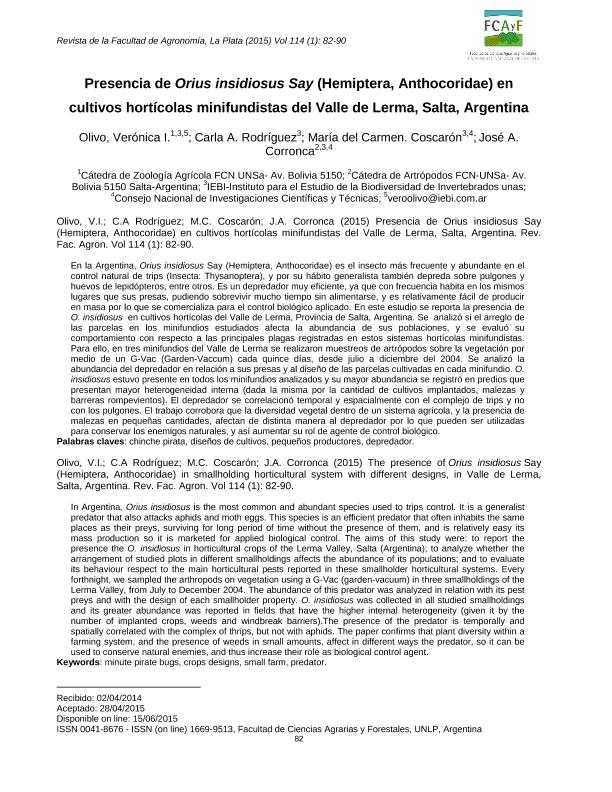Artículo
En la Argentina, Orius insidiosus Say (Hemiptera, Anthocoridae) es el insecto más frecuente y abundante en el control natural de trips (Insecta: Thysanoptera), y por su hábito generalista también depreda sobre pulgones y huevos de lepidópteros, entre otros. Es un depredador muy eficiente, ya que con frecuencia habita en los mismos lugares que sus presas, pudiendo sobrevivir mucho tiempo sin alimentarse, y es relativamente fácil de producir en masa por lo que se comercializa para el control biológico aplicado. En este estudio se reporta la presencia de O. insidiosus en cultivos hortícolas del Valle de Lerma, Provincia de Salta, Argentina. Se analizó si el arreglo de las parcelas en los minifundios estudiados afecta la abundancia de sus poblaciones, y se evaluó su comportamiento con respecto a las principales plagas registradas en estos sistemas hortícolas minifundistas.Para ello, en tres minifundios del Valle de Lerma se realizaron muestreos de artrópodos sobre la vegetación por medio de un G-Vac (Garden-Vaccum) cada quince días, desde julio a diciembre del 2004. Se analizó la abundancia del depredador en relación a sus presas y al diseño de las parcelas cultivadas en cada minifundio. O. insidiosus estuvo presente en todos los minifundios analizados y su mayor abundancia se registró en predios que presentan mayor heterogeneidad interna (dada la misma por la cantidad de cultivos implantados, malezas y barreras rompevientos). El depredador se correlacionó temporal y espacialmente con el complejo de trips y no con los pulgones. El trabajo corrobora que la diversidad vegetal dentro de un sistema agrícola, y la presencia de malezas en pequeñas cantidades, afectan de distinta manera al depredador por lo que pueden ser utilizadas para conservar los enemigos naturales, y así aumentar su rol de agente de control biológico. In Argentina, Orius insidiosus is the most common and abundant species used to trips control. It is a generalist predator that also attacks aphids and moth eggs. This species is an efficient predator that often inhabits the same places as their preys, surviving for long period of time without the presence of them, and is relatively easy its mass production so it is marketed for applied biological control. The aims of this study were: to report the presence the O. insidiosus in horticultural crops of the Lerma Valley, Salta (Argentina); to analyze whether the arrangement of studied plots in different smallholdings affects the abundance of its populations; and to evaluate its behaviour respect to the main horticultural pests reported in these smallholder horticultural systems. Every forthnight, we sampled the arthropods on vegetation using a G-Vac (garden-vacuum) in three smallholdings of the Lerma Valley, from July to December 2004. The abundance of this predator was analyzed in relation with its pest preys and with the design of each smallholder property. O. insidiosus was collected in all studied smallholdings and its greater abundance was reported in fields that have the higher internal heterogeneity (given it by the number of implanted crops, weeds and windbreak barriers).The presence of the predator is temporally and spatially correlated with the complex of thrips, but not with aphids. The paper confirms that plant diversity within a farming system, and the presence of weeds in small amounts, affect in different ways the predator, so it can be used to conserve natural enemies, and thus increase their role as biological control agent.
Presencia de Orius insidiosus Say (Hemiptera, Anthocoridae) en cultivos hortícolas minifundistas del Valle de Lerma, Salta, Argentina
Olivo, Veronica Ines ; Rodriguez, Carla Andrea
; Rodriguez, Carla Andrea ; Coscarón, María del Carmen
; Coscarón, María del Carmen ; Corronca, Jose Antonio
; Corronca, Jose Antonio
 ; Rodriguez, Carla Andrea
; Rodriguez, Carla Andrea ; Coscarón, María del Carmen
; Coscarón, María del Carmen ; Corronca, Jose Antonio
; Corronca, Jose Antonio
Fecha de publicación:
06/2015
Editorial:
Universidad Nacional de La Plata. Facultad de Ciencias Agrarias y Forestales
Revista:
Revista de la Facultad de Agronomía
ISSN:
0041-8676
e-ISSN:
1669-9513
Idioma:
Español
Tipo de recurso:
Artículo publicado
Clasificación temática:
Resumen
Palabras clave:
Chinche Pirata
,
Diseños de Cultivos
,
Pequeños Productores
,
Depredador
Archivos asociados
Licencia
Identificadores
Colecciones
Articulos(CCT - LA PLATA)
Articulos de CTRO.CIENTIFICO TECNOL.CONICET - LA PLATA
Articulos de CTRO.CIENTIFICO TECNOL.CONICET - LA PLATA
Citación
Olivo, Veronica Ines; Rodriguez, Carla Andrea; Coscarón, María del Carmen; Corronca, Jose Antonio; Presencia de Orius insidiosus Say (Hemiptera, Anthocoridae) en cultivos hortícolas minifundistas del Valle de Lerma, Salta, Argentina; Universidad Nacional de La Plata. Facultad de Ciencias Agrarias y Forestales; Revista de la Facultad de Agronomía; 114; 1; 6-2015; 82-90
Compartir



